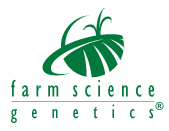Kitchen Seed Company offers both red clovers and white clovers. Our red clovers are elite, new generation red clovers. They were developed for above average disease resistance, higher yields and longer stand persistence; three or more years under proper management. Our white clovers are typically used for forage, wildlife, and erosion control. White clover is the most important pasture legume. It is highly palatable, nutritious forage for all classes of livestock and even wildlife. The varieties we have to offer exhibit extended grazing potential during colder months, superior growth, and excellent disease resistance.
ESTABLISHMENT
Red clover may be seeded in pure stands but it is often mixed with grain or grass. Spring or late summer seedings are satisfactory. It may be overseeded in the spring or fall. Red clover seed should be inoculated. Phosphorus and potash are the fertilizer elements needed most by red clover. Apply as recommended by soil tests. Seeding may be done with a drill or broadcaster. A firm, weed-free seedbed is essential. Plant seeds 1/4 to 1/2 inch deep. Seeding rates are 12 to 15 lbs/A broadcast and 6 to 8 lbs/A when drilled. For renovating pastures, the recommended seeding rate is 8 lbs/A.
MANAGEMENT
Graze or cut hay when the red clover is 1/4 to 1/2 bloom. A second cutting or successive grazings should occur when red clover is 1/4 in bloom. Leave at least 2 to 3 inches of growth after each harvest. Care shold be taken to eliminate or appreciably reduce bloating of livestock when grazing. Keep lime and fertilizers (phosphorus and potash) at the proper level. Kitchens Seed Company carries fertilizers suitable for red clovers.

ESTABLISHMENT
Red Clover may be seeded in pure stands, but it is often mixed with grain or grass. Spring or late summer seedings are satisfactory. It may be overseeded in the spring or fall. Red Clover seed should be inoculated. Phosphorus and potash are the fertilizer elements needed mostly by Red Clover. Apply as recommended by soil tests. Seeding may be done with a drill or broadcast. A firm, weed-free seedbed is essential. Plant seeds 1⁄4 to 1⁄2 inch deep. Seeding rates are 12 to 15 lbs./acre broadcast and 6 to 8 lbs./acre when drilled. For renovating pastures, the recommended seeding rate is 8 lbs./acre.
MANAGEMENT
Graze or cut for hay when the Red Clover is 1⁄4 to 1⁄2 in bloom. A second cutting or successive grazings should occur when Red Clover is 1⁄4 in bloom. Leave at least 2 to 3 inches of growth after each harvest. Care should be taken to eliminate or appreciably reduce bloating of livestock when grazing. Keep lime and fertilizers (phosphorus and potash) at the proper level.
FSG 402 is an elite new generation diploid medium red clover developed for higher yields and longer stand persistence; three or more years under proper management. FSG 402 reaches 50% bloom at approximately the same time as Arlington and Kenland, and 4 days earlier than Marathon in the spring and performs extremely well over a wide geographic area under variable growing conditions. FSG 402 is highly resistant to northern anthracnose, southern anthracnose and powdery mildew while showing an improved level of field resistance to black patch (Rhizoctonia) compared to Arlington, Marathon, Kenland and Freedom. Whether it’s for pastures, silage or hay, FSG 402 can’t be beat when it comes to yield, quality, stand persistence and disease resistance.
Newer varieties of medium Red Clover can be productive for 3 years or more under proper management. Plants have hollow, hairy stems and branches. Each leaf consists of a slender stalk bearing 3 leaflets. The taproot of Red Clover is extensively branched. Flowers are borne in compact clusters or heads and are usually rose-pink in color. Seed pods are small, short, and contain kidney-shaped seeds that vary in color from yellow to deep violet. There are approximately 272,000 seeds/pound.
Mammoth Red clover will fix up to 70-110 lbs. nitrogen per acre. The long tap roots loosen soils and mine phosphorus and other nutrients from deep in the soil. Mammoth can be planted almost any time of the year, sow in spring, summer or fall, alone or with grain/grass. It is larger and coarser than Medium Red Clover and is about two weeks later in maturity. Mammoth Red Clover is more drought-tolerant and productive than White Clover and usually not quite as high quality.
ESTABLISHMENT
The standard seeding rate is 2 to 4 pounds per acres, planted at a depth of 1/4 to 1/2 inch. For Pasture establishment, seeds are drilled into a well-prepared seedbed that has been plowed, harrowed and compacted to produce a firm seedbed. The seeds are inoculated before seeding. For stabilization use, seeds are broadcast on roadside cuts and fills by cyclone seeders, hydroseeders, or blower-type equipment. The proper time of seeding is determined by seasonal and moisture conditions. This may vary from April to May. Late summer and fall seedings should be conducted while adequate moisture is still in the soil to assure establishment before freezing.
MANAGEMENT
Management for forage is aimed at maintaining 40% to 50% clover. Close grazing (2 inch stubble height) favors clovers, whereas light grazing favors grass. Well-fertilized grass will outgrow clover in the fall and winter and could smother the clover. Spring applications of nitrogen will stimulate grass and provide early feed, but excessive rates are detrimental to the clover stand. Phosphate applications are broadcast in fall or spring according to soil tests. Sulfur, boron, or magnesium may be needed for maximum production on some soils in the western part of white clover’s range.
Will Ladino Clover is persistent in hot climates, has superior winter hardiness, and offers high yield potential. Developed jointly by the USDA and North Carolina State University, Will Ladino Clover is excellent for pastures and hay, and is widely adapted to different climates. This variety is known for excellent stolon development and establishment, and competes well against weeds. Will Ladino Clover’s large leaves are highly nutritious.
Alsike clover and grass mixtures are easierto harvest for hay because the grass holds the clovermore upright. Normally only one cutting can beharvested for hay in a season. It survives severe winters and performs best where summers are cool. It grows well on soils that are too acidic for red clover (pH < 6.0) and can tolerate more alkalinity than most clovers. It will tolerate wetter soils better than other clovers. Alsike clover does not tolerate droughty sites but will tolerate soils that are completely waterlogged and will withstand spring flooding up to 6 weeks. It is not shade tolerant.
Best establishment is achieved by fall seeding 40 days before first killing frost. This allows for the cool and moist conditions, common in the fall, to meet the moisture and root development requirements which are critical to achieve a good stand. Emergence occurs within 7-10 days and a slow establishment can be expected. White clover can be easily frost seeded into pastures from November-March. White clover has the ability to tolerate low fertility soils better than most other clovers but will preform best under fertile soil conditions. White clover displays excellent winter hardiness and shade tolerance but soil salinity won’t be tolerated.
Seminole is a very aggressive , high yielding ladino clover. It has thick runners and establishes very well and competes well even when it is interseeded into existing pastures. It has excellent regrowth even when under intensive grazing pressures. Can be planted in the Spring (February-May) or Fall (August-October). Plant 1/8 to 1/4 inch deep, in soils of a 6.0 pH level minimum.
Crusade white clover is the result of a breeding program that has taken the best traits of the traditional Haifa variety and combined them with improved winter activity qualities. Therefore, it can introduce added benefits in plant productivity and health to temperate regions where winter-active white clovers are desired. To develop this variety, selections were made from plants displaying superior growth in winter, autumn and spring. Other traits selected in the development of Crusade were very large, dark green leaves, early and vigorous flowering and high seed yield. A strong emphasis was also placed on freedom from virus and disease symptoms, and strong recovery from cutting, grazing and moisture stress. Crusade is a vigorous, large leaf, winter-active variety of white clover. Leaflets are similar in appearance to Haifa, but can have a darker green appearance with fewer leaf markings. Crusade is slightly earlier in flowering than Haifa. Because of its winter-active characteristic, Crusade will provide grazing during the colder months in regions experiencing mild moist winter conditions.
Korean lespedeza is a heavy seed producing great for hay, pasture, game birds, food plots and erosion control. Korean Lespedeza is earlier to mature than Kobe making Korean a better species for the Northern climates. Korean Lespedeza is very popular in food plots for turkey, quail and other game birds. If grown in pasture with other grasses, graze to keep grass from shading out the Lespedeza. Allow Lespedeza to go to seed once per year to maintain pasture.
Widely adapted with proven performance, Pardee birdsfoot trefoil was developed by the Cornell University Agricultural Experiment Station in Ithaca, NY. This upright, hay-type variety has an earlier maturity than both Norcen and Viking. Pardee was derived from a mixture of trefoil varieties and plant introductions. This genetic material was selected for vigor and resistance to Fusarium wilt. The result is a forage with greater disease resistance, better stand persistence and higher yields. Pardee can be used on poorly drained soils but will perform well on good soils, too. It has vastly improved winter survival over other trefoil varieties and recovers quickly after cutting. All of these characteristics contribute to higher yields over the life of the stand when compared to other varieties. In 1999 yield trials in New York, Pardee was the highest yielding variety in the first production year, was 37% more resistant to Fusarium wilt than unselected experimental varieties and 17% more resistant than Norcen and had the greatest number of plants per square foot in the first production year.
White Dutch tolerates shade and can be used as a companion crop with alfalfa or perennial ryegrass. Frost seed into winter cover crop in the spring. White Dutch clover crop is very tolerant of wet growing conditions. Wait two years before planting a vegetable legume because white clover is a host for root rot diseases such as Pythium and Rhizoctonia. Seed in the Fall (August 15-September 10, alone or with annual grass cover) or Spring (As early as possible, may be frost seeded like medium red clover).
White Blossom Sweet Clover is a legume that is later maturing than Yellow Blossom and is taller and coarser. It is palatable early and can also be hayed early. It is mostly used as a soil builder or bee habitat. This clover is a short lived perennial or biennial.
Yellow blossom sweetclover is not a true clover but is probably more closely related to alfalfa. Sweetclover leaves look much like alfalfa, but the margins of alfalfa leaflets are serrated only on the tips. Sweetclover leaflets are serrated around their entire margin. It is typically a biennial, grows 2-6 feet high, and as the name implies, produces yellow flowers. It is used for forage, cover cropping, conservation, and honey making. When compared to the white flowering types of sweetclover, yellow blossom blooms roughly 2 weeks earlier and also matures earlier, usually grows less upright, possesses finer stems, and is less productive and less winter-hardy. However, yellow blossom sweetclover persists better in pastures and tolerate adverse conditions better than white varieties. Sweetclover can produce and deposit a high percentage of hard seeds that persist in the soil for many years. This accounts for its consistent volunteering in many areas.

